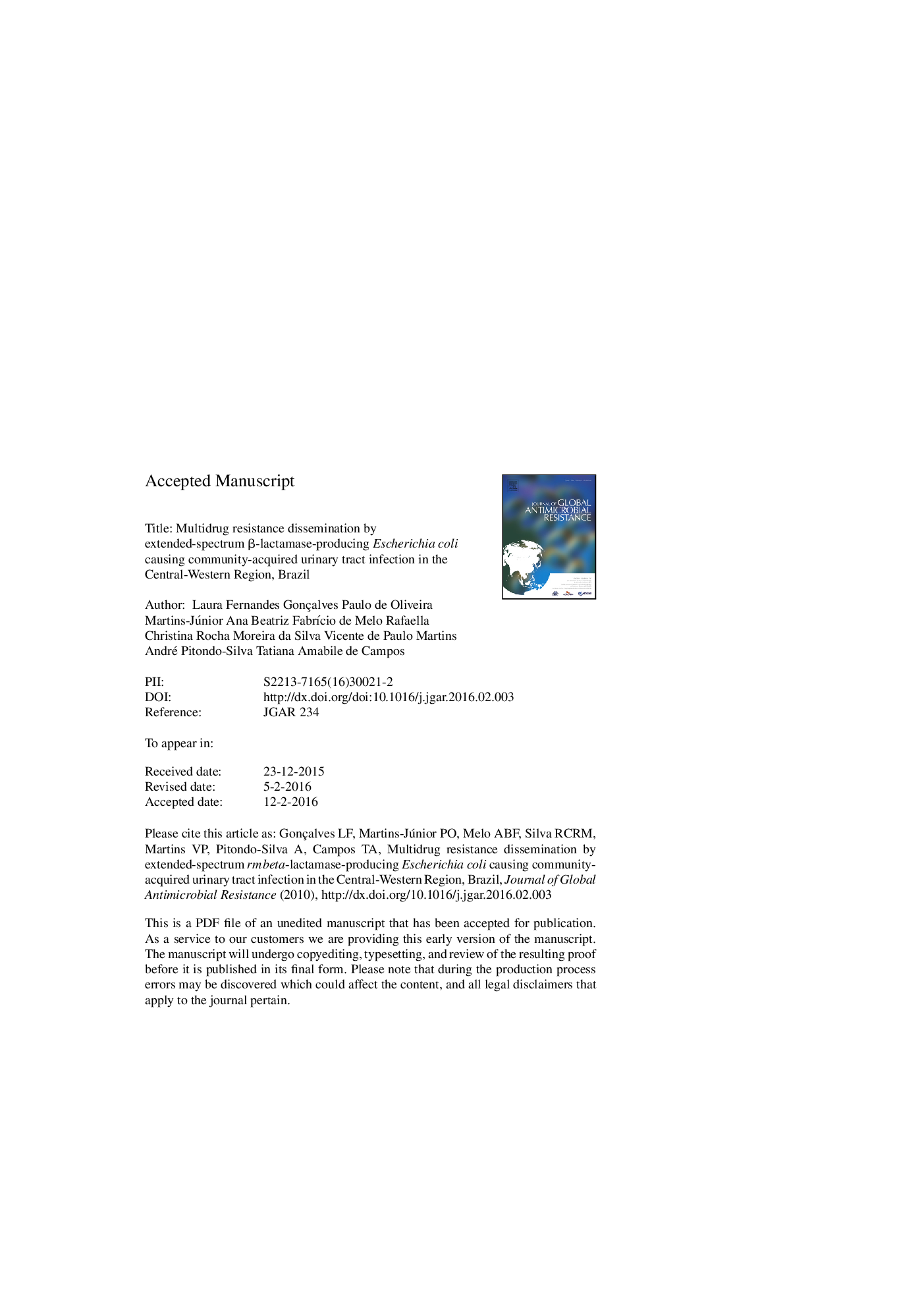| کد مقاله | کد نشریه | سال انتشار | مقاله انگلیسی | نسخه تمام متن |
|---|---|---|---|---|
| 8746672 | 1223470 | 2016 | 19 صفحه PDF | دانلود رایگان |
عنوان انگلیسی مقاله ISI
Multidrug resistance dissemination by extended-spectrum β-lactamase-producing Escherichia coli causing community-acquired urinary tract infection in the Central-Western Region, Brazil
دانلود مقاله + سفارش ترجمه
دانلود مقاله ISI انگلیسی
رایگان برای ایرانیان
کلمات کلیدی
موضوعات مرتبط
علوم زیستی و بیوفناوری
ایمنی شناسی و میکروب شناسی
میکروبیولوژی و بیوتکنولوژی کاربردی
پیش نمایش صفحه اول مقاله

چکیده انگلیسی
The aim of this work was to analyse extended-spectrum β-lactamase (ESBL)-producing Escherichia coli strains isolated from outpatients with signs of cystitis in Hospital Universitário de BrasÃlia (BrasÃlia, Brazil) during the period July 2013 to April 2014. E. coli isolated from urine culture were identified and their antibiotic susceptibility profile was determined by VITEK 2. ESBL-producing strains identified were submitted to PCR for Clermont phylotyping, CTX-M group typing and virulence determinant detection, and clonal relationships were determined by enterobacterial repetitive intergenic consensus (ERIC)-PCR. One strain belonging to each cluster of the dendrogram obtained by ERIC-PCR was selected for multilocus sequence typing (MLST). Among 324 uropathogenic E. coli (UPEC) analysed, 23 (7.1%) were identified as producing ESBL. All ESBL-producing strains were multidrug-resistant (MDR), i.e. presented non-susceptibility to at least one agent in three or more antimicrobial categories. Of the 23 ESBL-producing UPEC strains, 9 were assigned to phylogenetic group B2 and 7 each belonged to phylogenetic groups D and A. Virulence genotyping showed that aer was the most prevalent gene observed among the strains (21/23), followed by traT (18/23), pap (5/23), afa (5/23), PAI (5/23), cnf (3/23) and sfa (1/23). Analysis of the dendrogram showed that multidrug resistance and CTX-M ESBL groups were distributed among all strains, independent of clonality and phylogroup. Sequence types (STs) associated with pandemic resistance clones, such as B2-ST131 and D-ST648, were observed among the isolates. In conclusion, the results showed worrisome evidence of the potential for antibiotic multiresistant dissemination among community-acquired urinary tract infection caused by UPEC.
ناشر
Database: Elsevier - ScienceDirect (ساینس دایرکت)
Journal: Journal of Global Antimicrobial Resistance - Volume 6, September 2016, Pages 1-4
Journal: Journal of Global Antimicrobial Resistance - Volume 6, September 2016, Pages 1-4
نویسندگان
Laura Fernandes Gonçalves, Paulo de Oliveira Martins-Júnior, Ana Beatriz FabrÃcio de Melo, Rafaella Christina Rocha Moreira da Silva, Vicente de Paulo Martins, André Pitondo-Silva, Tatiana Amabile de Campos,